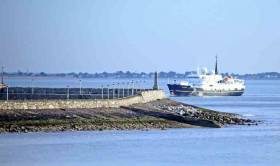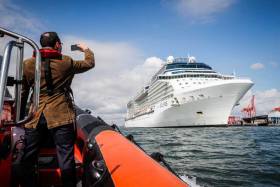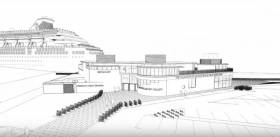Displaying items by tag: Cruise Liners
170 Cruise Ships to Visit Belfast Port This Season
The number of cruise ships expected to dock in Belfast Harbour this season represents a 20% increase on the previous record set in 2019. In 2019, Cruise Belfast opened the first dedicated cruise terminal on the island of Ireland, and this purpose-built facility can accommodate all vessels currently operating in the UK and Ireland region.
The cruise industry in Northern Ireland continues to provide a welcome boost to the economy. Michael Robinson, Port Director for Belfast Harbour, said: “With 170 vessels due to dock in Belfast this year, it’s clear that cruise tourism is back on track in 2023. Last year, we had 141 calls to the Port as we transitioned from the 2021 cruise season, which was still partially curtailed by the pandemic, but this year we are on course to surpass our previous record year in 2019 as the global industry returns to full capacity.
"15 ships calling to Belfast for the first time"
He continued: “Cruise visitors make an important contribution to Northern Ireland’s tourism mix, attracting visitors from across the globe on day trips to attractions all across the region. We’re expecting a quarter of a million passengers to arrive at Belfast Harbour this season, which will provide an estimated £20m boost to the local economy.”
 Gary Hall of Belfast Harbour and Mary Jo McCanny, Visit Belfast, with Lea Goodsell, the two millionth cruise ship passenger to visit Belfast Photo: courtesy Planetradio
Gary Hall of Belfast Harbour and Mary Jo McCanny, Visit Belfast, with Lea Goodsell, the two millionth cruise ship passenger to visit Belfast Photo: courtesy Planetradio
This season will feature six embarkation cruises departing from Belfast with Ambassador Cruise Lines, where local residents can start and finish their cruise in Belfast.
There will also be 15 ships calling to Belfast for the first time, including Disney Dream, Norwegian Prima and MSC Preziosa, as well as Ambassador Ambition, demonstrating Northern Ireland’s increasing popularity as a cruise destination and providing a testament to the quality of award-winning visitor attractions across the region.
 The Belfast Harbour Cruise Ship facility
The Belfast Harbour Cruise Ship facility
Mary Jo McCanny, Director of Visitor Servicing at Visit Belfast, added: “This is an exciting year for the city as the tourism offering is going from strength to strength with more visitor experiences such as the Titanic Belfast multimillion pound refresh, the launch of Titanic Distilleries and McConnell’s Distilleries and the reopening of HMS Caroline. The quality of our visitor attractions throughout the region continues to draw visitors from across the world, and the Visitor Services team is excited to welcome them shore-side this season.”
Last month, Belfast welcomed its two millionth cruise ship visitor; according to Cruise Belfast, the partnership between Belfast Harbour and Visit Belfast markets the city as a leading cruise ship destination. The passenger who took the number of visitors to come to Northern Ireland on cruise ships past the two million mark was Lea Godsell on board the Norwegian Dawn.
Impressive 'Le Bellot' Cruise Ship Docks in Dublin Port as Part of Circumnavigation of Ireland and UK
A new generation of a cruise ship docked in Dublin Port this week in the first port of call in a voyage around Ireland and the UK.
The 430-foot Le Bellot can welcome up to 184 guests and 118 crew members with limited capacity and is designed for landing in the most inaccessible locations, where other ships do not go.
The brand new ship is the fifth in the Ponant Explorer series and is currently on charter.
The ships offer 92 staterooms, including four suites; all cabins include a plate glass window and a private balcony.
She left from Honfleur, France, on May 21st, and her circumnavigation will end in Glasgow, Scotland, on May 29th.
Then, another charter will take the ship to Reykjavik, Iceland, until June 6th.
 After leaving Ireland, Le Bellot will sail around Iceland for a couple of months before heading to Canada
After leaving Ireland, Le Bellot will sail around Iceland for a couple of months before heading to Canada
The Norwegian expedition cruise liner, Maud, arrived in Waterford Port this morning, the first cruise vessel in over two years, due to Covid pandemic disruption.
It is the maiden voyage of the vessel, from the Norwegian cruise line company Hurtigruten. She arrived from the Isle of Man with over 500 passengers on board and 300 crew members. The vessel is named after one of the most famous Polar vessels -Roald Amundsen's 'Maud' - from 1917.
Waterford Harbour Master Capt. Darren Doyle said 27 cruise vessels will call to Waterford by the end of September with a total of 35,000 passengers and 16,000 crew members. “This will deliver a much-needed boost to the regional tourism economy of €3.5m.”
The Maud is scheduled to make nine more visits to Waterford this Summer.
The Celebrity Apex, which cost $900 million to build is scheduled to make her maiden visit in June and return in July and in August with over 3,000 passengers on each occasion.
Port of Cork and Cobh & Harbour Chamber to Hold Joint Virtual Workshop on Cruise Tourism
On Thursday 15th July, Cobh and Harbour Chamber and the Port of Cork will jointly host an online cruise tourism workshop. The workshop is aimed at local tourist attractions and providers and is a great opportunity to hear about the global cruise industry as destinations and Ports emerge from the pandemic, and the planned return of cruises to Cork in 2022.
The workshop will host several key speakers including Conor Mowlds, Chief Commercial Officer Port of Cork, Niamh McCarthy MD of Excursions Ireland, Captain Michael McCarthy Chair of Cruise Europe, Jackie Coakley Cobh Tourism and Seamus Heaney Pure Cork/Visit Cork.
 A Cruiser liner passes Crosshaven while exiting Cork Harbour Photo: Bob Bateman
A Cruiser liner passes Crosshaven while exiting Cork Harbour Photo: Bob Bateman
This workshop is a must for anyone in the tourism business that wants to get a synopsis of the cruise industry and how it will operate once it returns in 2022. It is also an opportunity for local businesses to explore ways of developing new shore excursions that can be sold to potential cruise passengers coming to Cobh and Cork.
President of Cobh & Harbour Chamber, Johanna Murphy said: ‘This cruise tourism workshop is such an exciting opportunity for local businesses and tourism attractions to hear first-hand from industry experts on the how we can all play our part in the resumption of cruise. Since the pandemic, Cobh has not had any visiting cruise ships and we are very eager to encourage their return as their economic contribution is valuable to the town of Cobh.’
 The 75,000 tonne Norwegian Spirit is a Leo-class cruise ship operated by Norwegian Cruise Line (NCL) Photo: Bob Bateman
The 75,000 tonne Norwegian Spirit is a Leo-class cruise ship operated by Norwegian Cruise Line (NCL) Photo: Bob Bateman
While cruise bookings are strong for 2022, the Port of Cork is cautiously optimistic that a resumption can happen once all necessary return protocols are in place.
Conor Mowlds, Chief Commercial Officer said: ‘Cruise tourism took a massive hit during the pandemic both locally and globally. We are nonetheless optimistic that cruise will return to Cork in 2022. We must now focus on developing a return to cruise protocol that will satisfy the Dept of Transport, Port Health, Cruise Lines, Shore Excursion providers local business and communities. This really is a combined effort from all parties to ensure the safe return and this cruise workshop is the first step in working together.’
 The Royal Princess alongside in Cobh in Cork Harbour Photo: Bob Bateman
The Royal Princess alongside in Cobh in Cork Harbour Photo: Bob Bateman
Cruise Liners in Cork Harbour Photo Gallery by Bob Bateman
Plans by Dublin Port Company is to develop the port stretches until 2040, reports Dublin Inquirer.
Right now, officials are pondering one piece of that plan.
They’re trying to decide whether to build specific berths for large cruise ships as part of the redevelopment of Alexandra Basin – and they want the public (see consultation), and interested stakeholders, to weigh in.
Currently, cruise ships berth at Alexandra Basin but with big works to kick off there in 2021, coupled with a growth in cargo, existing space is tight for the massive liners.
“We’re going to lose 400 metres of quay. A lot of bulk cargo goes there and we had to juggle things around,” says a spokesperson for Dublin Port.
One proposal is to build new specific berths, wide enough to be used by even the largest cruise ships. But whether they’re needed, or who would pay for them, are questions that Dublin Port officials are currently musing.
For much more and related issues click here.
The latest cruise ship from Saga Cruises, the highly anticipated 'Spirit of Discovery' has docked in Cobh on her make her maiden call to a wet Cork Harbour today.
As Afloat's Jehan Ashmore wrote yesterday, this brand new, luxury boutique British liner carries 999 passengers on board and was recently named by the Duchess of Cornwall, at an official naming ceremony in Dover.
Also as Afloat reported earlier, the Cork Harbour destination for the Spirit of Discovery was this week voted one of the world's top stopovers.
Saga Cruises have a rich history calling to the Port of Cork and have included Cobh on their British Isles cruise itinerary for many years now, as well as Belfast and Dublin. To mark the maiden calls to Dublin, Belfast and Cork, the ports and Excursions Ireland jointly commissioned a special shamrock magnet for every passenger on the inaugural cruise.
See photo gallery below
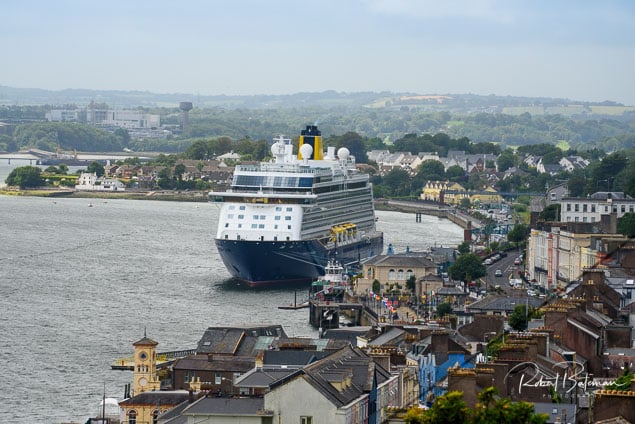
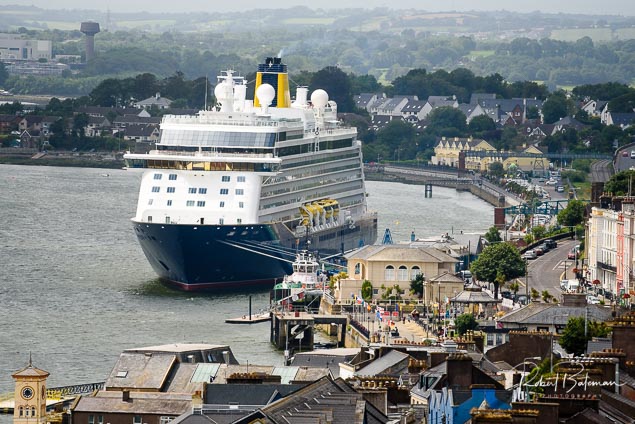
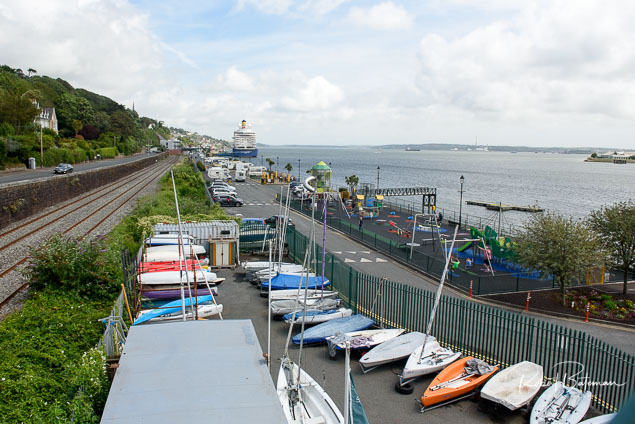
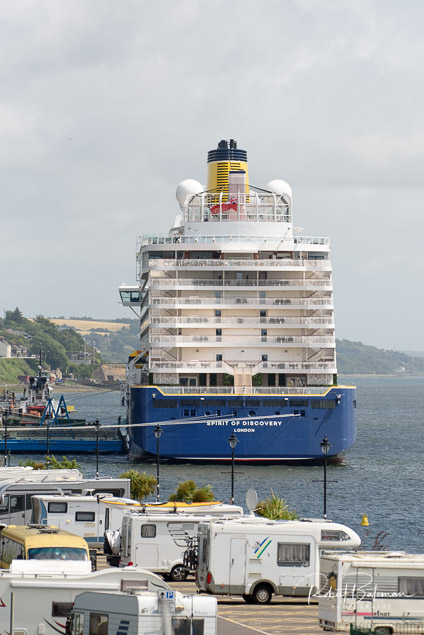
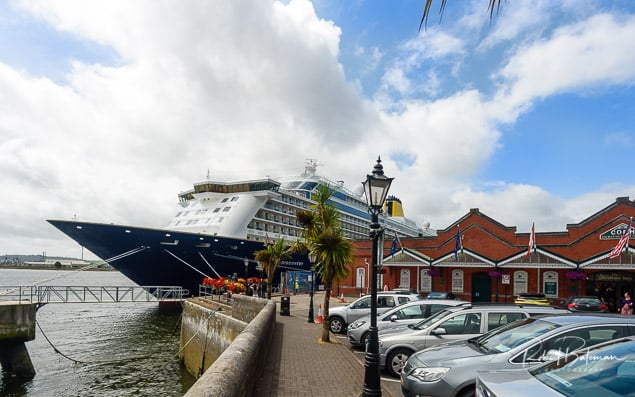

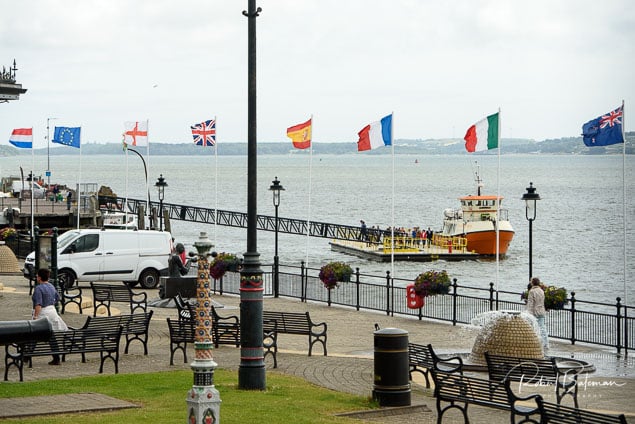
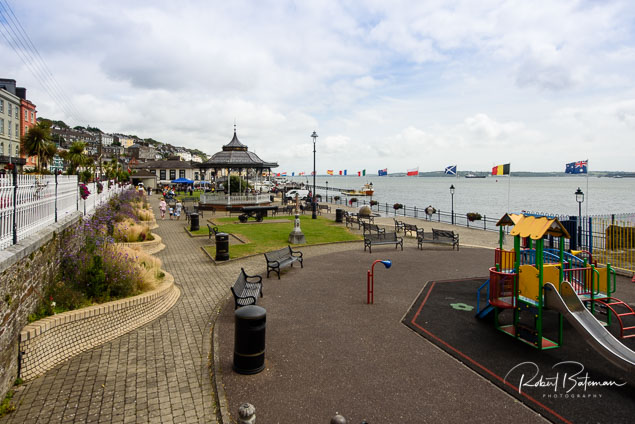

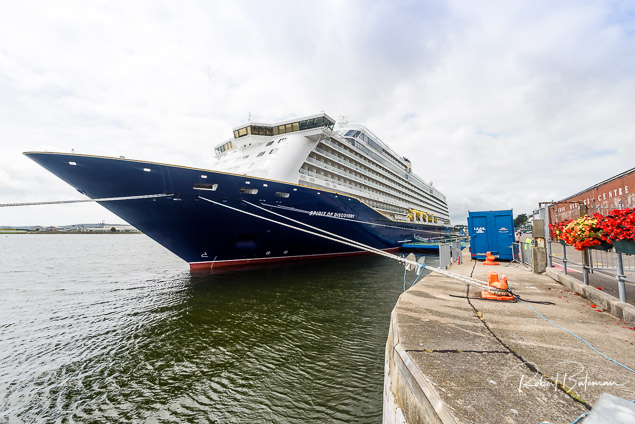

Dun Laoghaire-Rathdown County Council has said that “significant commercial, technical and environmental risk” had influenced its decision to withdraw a planning application for a 30 million euro cruise liner berth in Dun Laoghaire on Dublin Bay writes Lorna Siggins
In a statement to Afloat, the local authority said that the cruise berth planning application, originally made by Dun Laoghaire Harbour Company, was withdrawn by the council on May 14th.
“A report to council in May 2019 advised of the significant commercial, technical and environmental risk associated with this project,” a spokesman for the council said.
"Tourism interests predict Dún Laoghaire will still be a popular cruise ship destination"
Tourism interests have predicted that Dún Laoghaire will still be a popular cruise ship destination, in spite of Dun Laoghaire-Rathdown county council’s decision.
An Bord Pleanála has confirmed that the application for an eight-year permit to construct a cruise berth facility in Dun Laoghaire was withdrawn last week.
Independent senator Victor Boyhan has welcomed the move by the local authority but has said that “questions need to be answered” on the entire cost of the plan.
An Bord Pleanála had granted permission in November 2016 for the controversial cruise ship berth but had restricted the size of vessel which it could facilitate to 250 metres.
The original planning application by Dun Laoghaire Harbour Company aimed to accommodate cruise ships of up to 340 metres long, at a berth extending 435 metres.
The company had aimed to plan for the harbour’s future in the wake of Stena Line’s decision in 2015 to stop its ferry service between Dun Laoghaire and Holyhead. This broke the 170-year old ferry link between Dun Laoghaire and Wales – a service Stena had run from 1995.
The ruling was challenged by the Save our Seafront campaign group in a High Court judicial review, and the application was referred back to the planning appeals board.
In July 2017, An Bord Pleanála relisted the application to allow” issues raised at the judicial review” to be considered, according to a spokesman.
This elicited a strong reaction from the Combined Yacht Clubs grouping in Dun Laoghaire, which described as “shattering” the re-opening of the application.
The harbour has since been taken over by the local authority, and several months ago councillors were informed that it had no funds for a proposed €5 million urban beach, a €51 million diaspora centre and a €30 million cruise berth facility.
A progress report to councillors indicated that about €1 million had been spent on the cruise berth plan, of which €250,000 was provided by the council.
Senator Boyhan said the Dun Laoghaire Rathdown county council decision to withdraw the planning application “makes absolute sense”, given that the appeals board had received over 150 objections to the project.
“It was a crazy idea that should never have got so far, yet initially council planners were very supportive of the idea,” Mr Boyhan said.
“If it went ahead, it would have destroyed the heritage harbour and its environs,” he said, adding that “people must be held to account” for large costs incurred.
Excursions Ireland, which handles cruise ship visits to Irish ports, said Dun Laoghaire would still be a “great destination for cruise vessels”, although larger craft have to anchor off the harbour.
“We’d love it to be developed, particularly now that Dublin Port has announced it will have to restrict the number of cruise ships it can take from 2021 onwards due to capacity constraints,” Excursions Ireland managing director Niamh McCarthy said.
“However, some operators actually prefer Dun Laoghaire, and it is a great destination for the more independent guests,” she said.
Dun Laoghaire Cruise Ship Berth Project Abandoned
Tourism interests have said Dún Laoghaire will still be a cruise ship destination, in spite of Dun Laoghaire-Rathdown County Council’s decision to withdraw controversial plans for a 30 million euro cruise berth in the south Dublin harbour writes Lorna Siggins
An Bord Pleanála has confirmed that the application for an eight-year permit to construct a cruise berth facility in Dun Laoghaire was withdrawn last week.
Independent senator Victor Boyhan has welcomed the move by the local authority but has said that “questions need to be answered” on the entire cost of the plan.
"The application for an eight-year permit to construct a cruise berth facility in Dun Laoghaire was withdrawn last week"
An Bord Pleanála had granted permission in November 2016 for the controversial cruise ship berth but had restricted the size of vessel which it could facilitate to 250 metres.
The original planning application by Dun Laoghaire Harbour Company aimed to accommodate cruise ships of up to 340 metres long, at a berth extending 435 metres.
The ruling was challenged by the Save our Seafront campaign group in a High Court judicial review, and the application was referred back to the planning appeals board.
In July 2017, An Bord Pleanála relisted the application to allow” issues raised at the judicial review” to be considered, according to a spokesman.
This elicited a strong reaction from the Combined Yacht Clubs grouping in Dun Laoghaire, which described as “shattering” the re-opening of the application.
The harbour has since been taken over by the local authority, and several months ago councillors were informed that it had no funds for a proposed €5 million urban beach, a €51 million diaspora centre and a €30 million cruise berth facility.
A progress report to councillors indicated that about €1 million had been spent on the cruise berth plan, of which €250,000 was provided by the council.
Senator Boyhan said the Dun Laoghaire Rathdown county council decision to withdraw the planning application “makes absolute sense”, given that the appeals board had received over 150 objections to the project.
“It was a crazy idea that should never have got so far, yet initially council planners were very supportive of the idea,” Mr Boyhan said.
“If it went ahead, it would have destroyed the heritage harbour and its environs,” he said, adding that “people must be held to account” for large costs incurred.
Excursions Ireland, which handles cruise ship visits to Irish ports, said Dun Laoghaire would still be a “great destination for cruise vessels”, although larger craft has to anchor off the harbour.
“We’d love it to be developed, particularly now that Dublin Port has announced it will have to restrict the number of cruise ships it can take from 2021 onwards due to capacity constraints,” Excursions Ireland managing director Niamh McCarthy said.
“However, some operators actually prefer Dun Laoghaire, and it is a great destination for the more independent guests,” she said.
Meeting with Minister Ross & Cruise Ireland Seen as 'Positive Step' for Irish Cruise Industry
Chairman of Irish Cruise Liner body Cruise Ireland, Mr Conor Mowlds said; “Cruise Ireland welcomed the positive meeting held with Shane Ross TD, Minister for Transport, Tourism and Sport, Brendan Griffin TD, Minister of State with responsibility for Tourism and Sport, government agencies and other commercial bodies involved in supporting Ireland’s Cruise Industry.
The meeting was called by Ministers Ross to discuss Dublin Port’s temporary move to reduce cruise vessel calls to the capital while it develops additional essential port infrastructure during the interim period of 2021-2024.
The meeting provided an opportunity for the relevant bodies to consider the options available to Ireland that would help to reduce the impact on the Irish Cruise Industry following Dublin Port’s strategic decision.
With this meeting and the recent attendance at the Global Cruise Seatrade Exhibition in Miami, Cruise Ireland is confident that positive measures are being taken to mitigate the temporary impact on the industry, and we are committed to supporting the future marketing and promotion of Ireland as a premier cruise destination.”
‘Iconic’ Cruise Visitor Plans Approved for The Clyde
Plans have been approved for an iconic building on the banks of the Clyde at Greenock in the North Channel of the Irish Sea to welcome cruise ship passengers.
The plans, approved this month by Inverclyde planning board, are for a new visitor centre, restaurant and gallery at Greenock Ocean Terminal.
The overall project, led by Inverclyde Council, is part of the Glasgow City Region City Deal and aims to provide a new berthing facility and visitor centre to boost cruise ship passengers welcomed to Scotland through the Greenock facility operated by Peel Ports.
Now a key milestone, planning permission, has been granted.
In addition to the state of the art visitor centre welcoming cruise ship passengers from across the world, the plans also include a purpose-built gallery celebrating the work of Inverclyde resident and artist George Wyllie (1921-2012) and a new restaurant with panoramic views across the Clyde.
As part of the outline business case published by Inverclyde Council, it is estimated that over 150,000 passengers could pass through Greenock Ocean Terminal delivering £26m in annual visitor and crew spend to the Scottish economy.
Inverclyde Council Leader Councillor Stephen McCabe said: “Planning application approval is an important milestone in the delivery of this project as part of the Glasgow City Region City Deal. The aim of the project is to boost the capacity at Greenock Ocean Terminal for cruise ships. The addition of a restaurant and Wyllie Gallery will help to provide a year-round attraction for visitors to Greenock and Inverclyde at this iconic building on the banks of Clyde.
“As a key City Deal project, the new visitor centre at Greenock Ocean Terminal aims to make a significant contribution to economic growth and international tourism across the wider city region area.”
Councillor David Wilson, Inverclyde planning board convener, welcomed the approval of the planning application. He said: “This is a welcome application and one the board where wholehearted in their approval. Inverclyde has a great deal to offer the visitor whether coming to Scotland by cruise ship from all over the world or visiting from other parts of the United Kingdom. The new visitor centre, gallery and restaurant will enhance the offer to domestic and overseas visitors. The economic value of the cruise ship sector to Scotland is a key part of this project and its value to the country, particularly with the potential to substantially grow in future years, should not be underestimated.”
The proposal for a new Wyllie Gallery showcasing the life and work of the artist will also stage important exhibitions and events celebrating contemporary artists from across Scotland and further afield.
When the planning application was submitted, artist George Wyllie’s elder daughter, Louise Wyllie, said: “Inverclyde Council’s vision in realising this complex project is to be applauded.
“It has always been an ambition of The George Wyllie Foundation to celebrate and mark my father’s life and work in Inverclyde; an area which he loved and which was the lifeblood of all his art works.
“This exciting development at Ocean Terminal in Greenock marks a sea-change in the Foundation’s on-going voyage to mark his legacy as a ground-breaking artist and to make more people aware of his life’s work.
“Although making and creating art – be it music, plays or sculpture – was always a big part of his life, my father worked as a Customs and Excise officer for many years in this very spot. I know he would be thrilled that a world-class art space, designed by award-winning architect, Richard Murphy, was going to be part of a bigger picture which aims to inject new life into this area of Greenock.
Louise, who is also a trustee of the George Wyllie Foundation, added: “Giving access to arts for all was always part of my father’s approach to creativity and we can’t wait to get started on a host of exciting arts-for-all projects.”
The Greenock Ocean Terminal project to create a visitor centre and berthing facility is expected to cost £14.7m as part of the £1bn Glasgow City Region City Deal which is funded equally by the Scottish and UK governments.
The proposal for a new visitor centre landmark building for Greenock is being developed by Richard Murphy Architects, one of Scotland’s most celebrated architect firms. The company has won an unprecedented 22 RIBA Awards.
The visitor centre is scheduled for completion in 2020.





























